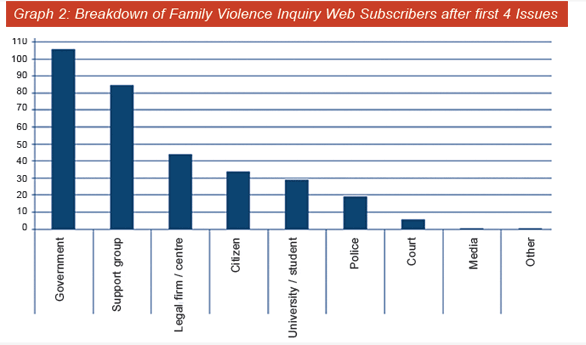14.10.2010
Table 8: Program 1.2 Key Achievements 2009–10
| Program 1.2 | Target | Actual |
|---|---|---|
| Reform journals distributed in hard copy | 1200 | 650 |
| Applications received for internships | 15 | 100 applications were received with 16 internships offered |
| Articles written for external publications | 10 | 16 |
| Presentations and information sessions | 25 | 21* |
| Media interviews | 35 | 20 |
| Website visits | 30,000 | 39,000 total visits, with 21,290 unique visitors for six months from Feb to June 2010 |
* From December 2009, the ALRC had only one full time Commissioner, thereby reducing the number of presentations and speaking engagements.
Reform journal
The ALRC made a decision to cease publication in hard copy of the journal Reform and only published one edition in this reporting period, hence the lower than estimated number of journals distributed. This decision was based on an unforeseen reduction in the ALRC’s appropriation and the consequent need to focus on our core activity of conducting inquiries.
Applications received for internships
The ALRC’s internship program continued to receive a high level of interest from law students around the country with 100 applications being received and 16 internships offered during the reporting period. A discussion of the internship program is included in the special features section.
Articles written for external publications
A total of 16 journal articles were written for external publications by ALRC Commissioners and staff. A list of these articles is in Appendix I.
Presentations and information sessions
A full list of presentations by ALRC Commissioners and staff is in Appendix I.
Media interviews
The 20 media interviews conducted mainly concerned aspects of the ALRC’s Privacy Report (Report 108, 2008)—in particular media interest in credit reporting—and the announcement of the ALRC’s Inquiry into Family Violence.
ALRC website
Approximately six months into the reporting period, a new web statistics tool, Google Analytics, was implemented to allow a better assessment of website traffic. As the previous analytics tool utilised a different methodology for counting visits and provided different and less reliable figures and metrics, details are only provided for the past 6 months.
During 2009–10, the ALRC ran an open tender for the development of its new website and integration with a Content Management System (CMS) in the interests of obtaining a good range of competitive quotes. The Request For Tender (RFT) was advertised on AusTender on 1 October 2009, with a closing date of 9 November 2009. There were approximately 200 requests for the RFT documents. By the closing date, the ALRC had received 26 formal tenders with budgets ranging from $44,500– $258,860. The ALRC shortlisted five companies to present their proposals and ranked each against a set of criteria as outlined in the ALRC’s Procurement and Purchasing Policy.
In December 2009, the ALRC commissioned PreviousNext, a website design and development consultancy based in Sydney and Melbourne, to carry out the works using Drupal (an open source CMS). The new website is scheduled to launch in August 2010. The key functional features of the new website will be integrated social media applications and Web 2.0 tools (such as forums, blogs, rss feeds, etc), and an online submissions tool that simplifies the submission process for stakeholders and streamlines the handling and management of submissions. Key design features will be a more user-friendly and accessible presentation of ALRC final reports and consultation documents; design elements that improve accessibility; and a more user-friendly interface that increases transparency and promotes interest and participation in the ALRC’s work.
The new website will also have new or enhanced accessibility features and has been designed to be fully compliant with the recently released WCAG 2.0 standards.
With the release of the Family Violence Consultation Paper and the ALRC’s call for submissions, the ALRC launched the Family Violence Online Submission Form as a pilot project. The primary goals of the project were to encourage maximum stakeholder engagement by simplifying the submission writing process, to encourage more focused responses and to simplify the management and assessment of submissions for ALRC staff.
Key features included:
- the ability to begin a submission and save work over a number of sittings;
- an option to respond only to those questions/proposals of interest or within the experience of each respondent;
- the ability to upload a supporting document or pre-prepared submission; and
- the ability to enable the ALRC legal team to compile and download reports on responses to specific questions.
At the closing date for submissions on 25 June 2010, 64 submissions had been completed using the online submission tool. The Online Submission Form provided an opportunity to trial software associated with the Drupal CMS on which the new website is being built.
ALRC e-newsletters
In 2009 the ALRC decided to explore the potential of e-newsletters for disseminating news and generating interest in the ALRC’s work. The first e-newsletter to be developed was specifically for the Family Violence Inquiry and sent on 9 November 2009 to an email list compiled from the ALRC database. The e-newsletter was promoted on the ALRC’s home page and Twitter posts. A notice was also posted on Australian Policy Online. The original database list comprised 284 contacts. By July, after eight e-newsletters, web subscribers swelled the list to 940, representing a growth rate of 230%.
View the Family Violence inquiry newsletters.

The ALRC has received positive feedback about the e-newsletter from recipients and stakeholders and it has proved an effective way of disseminating information and engaging stakeholders in the Inquiry, and managing stakeholder expectations. A similar strategy is in place for the new Discovery Inquiry.
